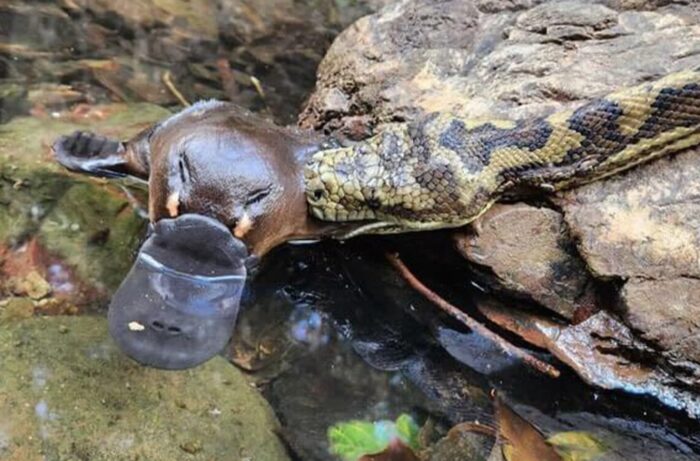In a striking encounter documented in Queensland, Australia, ecologist Elliot Bowerman and his friend came across a scene that would thrill any wildlife observer: a carpet python was clamped onto a male platypus by its foot. The snake, measuring around two meters in length, was seen in a nearby creek with its prey. Though initially alarming, Bowerman noted the platypus was already deceased, implying that the predatory event had transpired moments before their arrival. They refrained from disturbing the snake and instead took photographs of this rare interaction, reflecting a respect for wildlife and an understanding of ecological dynamics.
Bowerman’s observations indicate that the lack of odor from the platypus suggested a recent kill, as rigidness associated with rigor mortis had not yet set in. He speculated that the platypus had likely put up considerable resistance due to its venomous spurs, highlighting the ferocity of its fight against the snake. This incident stands out as an unusual occurrence given that the platypus is not typically preyed upon by snakes. Expert Tamielle Brunt, who specializes in platypus conservation through the PlatypusWatch program, described the images from Bowerman’s encounter as incredible. Such an event serves as a reminder of the complex and often surprising interactions within ecosystems.
Historically, platypuses in Australia face threats primarily from birds of prey, like sea eagles and hawks, which can easily pluck them from aquatic environments. Invasive species, such as cats and foxes, also pose significant risks to these unique mammals. However, direct predation by snakes is not commonly reported. Instead, snakes have been known to target platypus eggs rather than the adult animals themselves. This incident marks a rare exception that may indicate shifts in predator-prey dynamics or changes in local wildlife populations.
Bowerman’s knack for witnessing unusual animal behaviors has been further demonstrated by a past encounter where he observed cannibalism among antechinus, a carnivorous marsupial mouse. This historic observation marks the first recorded instance of cannibalism within this species, underscoring the unpredictability of wildlife behavior and the importance of field research for biologists and ecologists. Such experiences reinforce the value of understanding animal interactions, as they provide firsthand insights into behavior that may not conform to established patterns.
The unique nature of the platypus itself, an egg-laying mammal with physical characteristics reminiscent of various animals, adds a layer of intrigue to the encounter. As one of the few monotremes in existence, platypuses hold a special place in the study of evolutionary biology. Their fascinating biology and rarity elevate the significance of the python’s predation, as each interaction helps to build a more comprehensive picture of how species interact within their environment.
In conclusion, Bowerman’s experience showcases the unexpected and breathtaking moments that can occur in nature. The sight of a python eating a platypus presents a curious case for wildlife ecologists, prompting discussions about predation patterns, ecological balance, and species interactions. As researchers continue to study these relationships, each observation like Bowerman’s contributes valuable data that enhance our understanding of biodiversity and the challenges that various species face in their habitats. The gathering of such rare instances serves to highlight the complexity and sometimes harsh realities of life in the wild.

